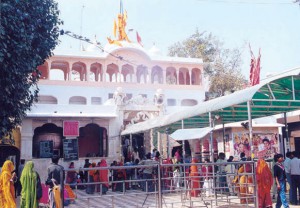Khatushyam Temple
After the Mahabharata battle, Barbarika's head was drown in the river name rupawati by lord krishna giving lots of blessings.After many years when kalyug started the head was found buried in the village of Khatu in present-day Rajasthan. The location was obscured until well after the Kaliyuga period began. Then, on one occasion, milk started flowing spontaneously out of a cow's udder when she neared the burial spot. Amazed at this incident, the local villagers dug the place up and the buried head was revealed. The head was handed over to a Brahmin who worshipped it for many days, awaiting divine revelations as to what was to be done next. Roopsingh Chauhan, king of Khatu, then had a dream where he was inspired to build a temple and install the head therein. Subsequently, a temple was built and the idol was installed on the 11th day of the Shukla Paksha (bright half) of the month of Phagun.
 There is another, only slightly different version of this legend. Roopsingh Chauhan was the ruler of Khatu. His wife, Narmada Kanwar, once had a dream in which the deity instructed her to take his image out of the earth. The indicated place (now known as Shyam Kund) when then dug up. Sure enough, it yielded the idol, which was duly enshrined in the temple.
There is another, only slightly different version of this legend. Roopsingh Chauhan was the ruler of Khatu. His wife, Narmada Kanwar, once had a dream in which the deity instructed her to take his image out of the earth. The indicated place (now known as Shyam Kund) when then dug up. Sure enough, it yielded the idol, which was duly enshrined in the temple.
 The original temple was built in 1027 AD by Roopsingh Chauhan and his wife Narmada Kanwar. In 1720 AD, a nobleman known as Diwan Abhaisingh renovated the old temple, at the behest of the then ruler of Marwar. The temple took its present shape at this time and the idol was enshrined in the sanctum sanctorum. The idol is made of rare stone. Khatushyam is the family deity of a large number of families.
The original temple was built in 1027 AD by Roopsingh Chauhan and his wife Narmada Kanwar. In 1720 AD, a nobleman known as Diwan Abhaisingh renovated the old temple, at the behest of the then ruler of Marwar. The temple took its present shape at this time and the idol was enshrined in the sanctum sanctorum. The idol is made of rare stone. Khatushyam is the family deity of a large number of families.
His another temple is located at Vasna, Ahmedabad, Gujarat where people are coming with their newly born child to have blessings of Khatushyam. Here he is known as Baliya Dev.

History – Why it is called Khatu Shyam Ji Temple ?
The legend of this immensely popular Krishna temple can be traced back to the medieval Mahabharat where Barbareek, the son of great Pandav brother Bhim and Nag Kanya (snake princess) displayed his great warrior skills that pleased Lord Shiva who endowed his blessings in the form of Teen Ban (three arrows)
In order to watch the famous war of Mahabharat, he sat towards the battle field and in between his tryst with Lord Krishna in disguise becasme a vital part of the history and thus the incarnation of KHATU SHAMJI.
Architecture of the Temple
The temple is architecturally rich. Lime mortar, marble and tiles have been used in constructing the structure. The shutters of the sanctum are beautifully covered with silver sheet.
Outside is the prayer hall, named Jagmohan and its walls are elaborately painted, depicting mythological scenes. The entrance gate and exit gate are made of marble; their brackets are also of marble and feature ornamental floral designs.
There is an open space in front of the entrance gate of the temple. The Shyam Bagicha is a garden near the temple from where flowers are picked to be offered to the deity. The Samadhi of Aloo Singh, a great devotee, is located within the garden.
The Gopinath temple lies to the south-east of the main temple. The Gaurishankar temple also lies nearby. There is an interesting tale associated with the Gaurishankar temple.
There is a steady stream of devotees the year round, but lakh of them gather at the annual fair from Phalgun Sudi Dashmi to Dwadashi. Apart from being a place of pilgrimage, a large number of people come for the Jadula ceremony (the first time all hair is shaved off the head) of their children.

